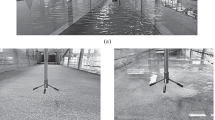Abstract
In this study, three dimensional quadrant analysis of bursting process was used to recognize the susceptible regions for sediment entrainment and deposition at the bed of a vortex chamber. From the analysis, it was found that two dimensional quadrant analysis in unable to find the turbulent coherent structure of flow near the bed of the vortex chamber. Therefore, a new method based on three dimensional bursting process is introduced in this study to define the turbulent flow structure. Based on the new methodology in this study, the bursting event is divided into eight different cube zones according to three dimensional velocity fluctuations. It was realized that, four cube zones interactions are toward the central orifice of the vortex chamber and four cube zones interactions are toward the wall of the chamber and they are categorized as classes A and B, respectively. The results from the experiments showed that in class A, the internal sweep events (class IV-A) moves the settled sediment particles toward the central orifice of the chamber, whereas in class B the external sweep events (class IV-B) moves the settled sediment particles toward the external region of the chamber. Also the transition probabilities of the bursting events in 64 particular movements were determined. The result showed that stable organizations of each class of the events had highest transition probabilities whereas cross organizations had lowest transition probabilities. Additionally, an effort was made to find the average inclination angle of the three dimensional bursting events in each cube zone. The results showed that near the bed of the vortex chamber by increasing the tangential velocity toward the center of the chamber, the average inclination angle of the events in the cube zones decreased. Also, at the region where the sediment particles were deposited, the inclination angles had higher values.

















Similar content being viewed by others
References
Drake TG, Shreve RL, Dietrich WE, Whiting PJ, Leopold LB (1988) Bed load transport of fine gravel observed by motion-picture photography. J Fluid Mech 192:193–217
Grass AJ (1971) Structural features of turbulent flow over smooth and rough boundaries. J Fluid Mech 50(2):233–255
Hinze JO (1975) Turbulence 2nd Edition. McGraw-Hill
Keshavarzi AR (1997) Entrainment of sediment particles from a flat mobile bed with the influence of near-wall turbulence PhD Thesis. University of New South Wales, Australia
Keshavarzi AR, Ball JE (1997) An analysis of the characteristics of rough bed turbulent shear stress in an open channel flow. J Stochastic Hydrol and hydraulics 11(3):193–210
Keshavarzi AR, Ball JE (1999) An application of image processing in the study of sediment motion. J Hydra Res 37(4):559–576
Keshavarzi A, Shirvani A (2002) Probability analysis of instantaneous shear stress and entraind particles from the bed. CSCE/EWRI of ASCE Environmental Engineering Conf, Niagara
Kline SJ, Reynolds WC, Schraub FA, Runstadler PW (1967) The structure of turbulent boundary layers. J Fluid Mech 30(4):741–773
Nakagwa H, Nezu I (1978) Bursting phenomenon near the wall in open channel flow and its simple mathematical model. Mem Fac Eng Kyoto University, Japan XL(4) 40:213–240
Nelson JM, Shreve RL, Mclean SR, Drake TG (1995) Role of near-bed turbulence structure in bed load transport and bed form mechanics. Water Res Res 31(8):2071–2086
Nezu I, Nakagawa H (1993) Turbulence in open channel flows. IAHR Monograph, Balkema, Rotterdam
Nychas SG, Hershey HC, Brodkey RS (1973) A visual study of turbulent shear flow. J Fluid Mech 61:513–540
Offen GR, Kline SJ (1975) A proposed model of the bursting process in turbulent boundary layers. J Fluid Mech 70:209–228
Papanicolaou AN, Diplas P, Evaggelopoulos N, Fotopoulos S (2002) Stochastic incipient motion criterion for spheres under various bed packing conditions. J Hydraulic Eng ASCE 128(4):369–380
Sontek ADV Operation Manual (1997) Firmware Version 4.0. Sontek:San Diego
Thorne PD, Williams JJ, Heathershaw AD (1989) In situ acoustic measurements of marine gravel threshold and transport. Sedimentology 36:61–74
Townsend AA (1956) The structure of turbulent shear flow. Cambridge University Press, Cambridge
Yalin MS (1992) River mechanics. Pergamon Press Ltd, Oxford
Yen BC (2002) Stochastic inference to sediment and fluvial hydraulics. J Hydraulic Eng, ASCE 128(4):365–367
Author information
Authors and Affiliations
Corresponding author
Rights and permissions
About this article
Cite this article
Keshavarzi, A.R., Gheisi, A.R. Stochastic nature of three dimensional bursting events and sediment entrainment in vortex chamber. Stoch Environ Res Ris Assess 21, 75–87 (2006). https://doi.org/10.1007/s00477-006-0045-6
Published:
Issue Date:
DOI: https://doi.org/10.1007/s00477-006-0045-6




